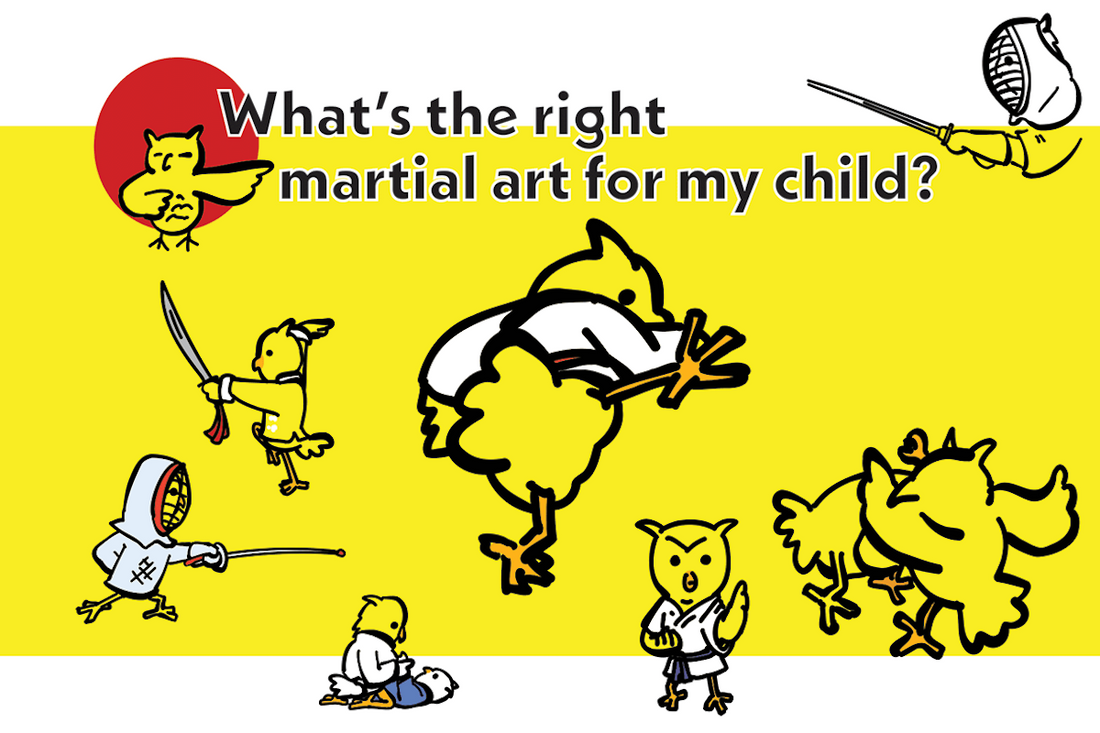
What's the right martial art for my child?
Share
You won’t find a guide to raising kids that will deny the value of martial arts for kids, and for good reason. They teach focus, discipline, and develop bodies like few other sports. Coordination, working with others, respect — if you can find the right school, a martial arts program can do it all for your child (or you). At Wonder Owls we have a couple of projects that include the martial arts, so we thought we’d weigh in on this big extra-curricular option.
So… which one is best for your child?
As with any big decision, it depends. Let’s look at a couple of factors, then go through some of the most popular choices.
Age
How old your child is can really affect which art you choose. Some arts have more sparring or partner practice that you may feel is too hard for little ones, and some may not give your bigger child enough activity.
Ask yourself what your child needs. Are you looking for that coordination that helps younger kids, or the rigidity that helps modify behavior in middle schoolers? Perhaps you need actual martial training for safety, or need deeper philosophical training for a thoughtful child.
Greatest effect
What art gives them the greatest effect? What do they like the most, and what makes sense for the length of time that they will practice?
Let’s go through some popular choices.

Karate
Top of the list is the Japanese art of Karate, a long time favorite of parents for its strong sense of values, this effective art is characterized by sharp, direct, and strong movements.
Age: All ages above 4, sparring practice begins at 7 at most schools
Developmental needs: Coordination, strength, respect, structure, philosophy (depending on school)
Type of practice: Can be practiced alone or with a partner, with set forms, and a tiered ranking system

Tae Kwon Do
Sometimes referred to as the Korean Karate, this popular martial art has a reputation for kicking, and a strong Olympic following.
Age: All ages above 4, sparring practice begins at 6 at most schools
Developmental needs: Coordination, strength, respect, structure, philosophy (depending on school)
Type of practice: Can be practiced alone or with a partner, with set forms, and a tiered ranking system

Kung Fu
Kung Fu (Gong Fu) is the general term for Chinese martial arts, so to speak generally about the variety of styles, Kung Fu is known for applying strength through complex movements. While some styles may seem like a combative dance, and others like boxing, all of them have punches and kicks in their systems. A closer look at the school and style is always a good idea when shopping for an art. Many include weapons training as well, with swords, spears, and traditional Chinese weapons,
Age: All ages above 4, sparring practice depends on school
Developmental needs: Coordination, strength, respect, structure
Type of practice: Can be practiced alone, with set forms, and a tiered ranking system

Capoeira
The Brazilian art of Capoeira is a combination of martial arts, music, and dance that has a following all its own. Its players (practitioners) form a ring, chant and sing as individual members challenge each other in the middle. It is a melodic and deceptively martial art, that builds strength as it does coordination.
Age: All ages above 4, sparring practice is integrated with practice (it should be said that most sparring, or ‘playing’ as they call it, aims to show how you could hit the other person without actually hitting. This actually makes most sparring quite safe, and teaches control to the learner.)
Developmental needs: Coordination, strength, respect, music
Type of practice: Movements and techniques can be practiced alone, yet the majority of learning is in the class with instructors.

Jiu Jitsu
There are two forms of Jiu JItsu, the original Japanese, and the more common Brazilian Jiu Jitsu, both of which are wrestling arts. It is a very martial art with joint locks, pins, and groundwork that has a reputation for its combat.
Age: All ages above 5, sparring practice is integrated with practice
Developmental needs: Coordination, strength, respect
Type of practice: Partner practice is required for this art, where two people are trying to pin one another. Classes are required for it

Sword Arts

We've put two other martial arts in here that have become popular choices for parents, Kendo and Fencing. Both are for kids older than 6 and have their own path for competitions. Fencing is often taught as a sport, with off-campus schools competing among each other. Kendo is taught as a martial art, with a familiar dojo-style practice. Both foster strength, coordination, and sportsmanship.
Naturally, there are many more martial arts out there, from Judo to Wing Chun, but we’ve given a short list of styles that are easily found in many areas. In some cases we excluded some styles for their practice styles, and other for the sheer amount of bouncing the little noggins would take. Not every art is right for a child, and not every art has the social component that will help your child in school. Always check out the school, the teachers, and take a trial class. If the school doesn't offer one, that's a bad sign!
If you would like hear more, or find out more about Wonder Owl’s projects, let us know. We’re always happy to hear from you!
